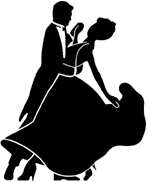
Area Classes • Medal Tests• Yoga/Fitness • Testimonials • Photo/Video Gallery • For Sale • Links •Contact Us
What Dances Can I Learn?
Your dance program will be designed around the dances you want to learn. Dances you may want to consider are: |
 |
Foxtrot – Foxtrot stands out as the standard of all Social Dances and is America’s most popular dance. It’s unique walking movement cam be applied to most of the slower contemporary pieces of music heard today. Variations of the Foxtrot include, Two-Step, Shag, Peabody, and Quickstep.
Waltz – Originating in Germany, the Waltz was the first dance in which people embraced. Considered scandalous in it’s time, most of today’s dances derived their basics from the Waltz, the mother of all social dances. Viennese Waltz is the fastest version of dance and characterized by an almost continual spinning motion. It is frequently seen in movies.
Tango – The Tango’s origin can be traced back many years to Argentina and Spain and was made famous in America through the movies. This beautiful dance is done today by more serious dancers but should be considered by all. There are three styles of Tango – American, International, and Argentine which all have their own unique look.
Rumba – Rumba has become one of the most popular social dances of our time. Danced to music made popular by numerous Latin entertainers, its slow, romantic rhythms have made Rumba the dance of romance.
Cha Cha – Cha Cha is one of the most popular Latin dances and can be done to both authentic Latin rhythms and today’s popular top 40 tunes played in night clubs. Its unique syncopated rhythm helps one develop body movement and dance personality. It is derived from Mambo.
Swing – Swing is a dance that has been around for decades and because of its personality and quick moving nature it will be around for decades to come. This dance is also known as the Rock ‘n Roll, Jive, Jitterbug, Lindy or Swing and has three rhythms: single, double, or triple. To enjoy Swing to the fullest, a dancer should be able to do all three rhythms.
Merengue – Merengue is a social must for all to learn, whether dancing to exotic rhythms of the islands or the pulsating beats in night clubs today. This dance and it’s marching rhythm crosses all age and language barriers and can be enjoyed by all because of it’s simple, fun and inspirational music.
Samba – Brazil’s National Dance, the Samba, has become even more popular today because of its jovial and exciting movement. This dance has a unique look combined with the familiar patterns of Waltz and because of this, the name “Brazilian Waltz” has been given to the Samba.
Mambo – Mambo is a “dancer’s dance” that stresses timing and a somewhat controlled frenzy of body movement. Its Cuban/African beginnings became popular in America during the 40’s and 50’s and is part of today’s most popular night club music. Mambo & Salsa are essentially the same dance with minor variations.
Hustle – Hustle should be known as the dance that bridged touch dancing from the past and the freestyle movements of the discos. An exciting dance that has its own unique style and should be credited as the dance that brought younger people back together on the dancefloor.
|
|
Connie Reeves • (608) 335-2982 • info@toplinestudio.com